Final Fantasy _ Video Game series
| 1987 – | – Final Fantasy | |
| 1988 – | – Final Fantasy II | |
| 1989 – | ||
| 1990 – | – Final Fantasy III | |
| 1991 – | – Final Fantasy IV | |
| 1992 – | – Final Fantasy V | |
| 1993 – | ||
| 1994 – | – Final Fantasy VI | |
| 1995 – | ||
| 1996 – | ||
| 1997 – | – Final Fantasy VII | |
| 1998 – | ||
| 1999 – | – Final Fantasy VIII | |
| 2000 – | – Final Fantasy IX | |
| 2001 – | – Final Fantasy X | |
| 2002 – | – Final Fantasy XI | |
| 2003 – | ||
| 2004 – | ||
| 2005 – | ||
| 2006 – | – Final Fantasy XII | |
| 2007 – | ||
| 2008 – | ||
| 2009 – | – Final Fantasy XIII | |
| 2010 – | – Final Fantasy XIV | |
| 2011 – | ||
| 2012 – | ||
| 2013 – | ||
| 2014 – |
Square Co., Ltd. first entered the Japanese video game industry in the mid 1980s, developing a variety of simple RPGs for Nintendo's Famicom Disk System (FDS), a disk-based peripheral for the Family Computer (also known as the "Famicom," and known internationally as the Nintendo Entertainment System). By 1987, declining interest in the FDS had placed Square on the verge of declaring bankruptcy.
At approximately the same time, Square designer Hironobu Sakaguchi began working on an ambitious new fantasy role playing game for the cartridge-based Famicom, inspired in part by Enix's popular Dragon Quest (originally known in the United States as Dragon Warrior). Recognizing that the project could very well turn out to be Square's last game, the project was titled Final Fantasy. Far from being Square's last installment, however, Final Fantasy reversed Square's lagging fortunes, and became Square's flagship franchise.
Following the success of the first game, Square quickly began work on a sequel. Unlike a typical sequel, Final Fantasy II featured entirely different characters, with a setting and story bearing only thematic similarities to its predecessor. This unusual approach to sequels has continued throughout the series, with each major Final Fantasy game introducing a new world, and a new system of gameplay. Many elements and themes would recur throughout the series, but there would be no direct game sequels until the release of Final Fantasy X-2 in 2003, though Final Fantasy V received an anime sequel prior to this.
After the merge with Enix, however, real game sequels have become increasingly prevalent. In a way, the Final Fantasy franchise has been a creative showcase for Square's developers, and many elements originally introduced in the series have made their way into Square's other titles, most notably two of its other major franchises, SaGa and Seiken Densetsu.
The first installment of the series premiered in Japan on December 18, 1987. Subsequent titles are numbered and given a story unrelated to previous games; consequently, the numbers refer more to volumes than to sequels. Many Final Fantasy games have been localized for markets in North America, Europe, and Australia on numerous video game consoles, personal computers (PC), and mobile phones. Future installments will appear on seventh and eighth generation consoles; upcoming titles include Final Fantasy XV. As of January 2014, the series includes the main installments from Final Fantasy to Final Fantasy XIV, as well as direct sequels and spin-offs, both released and confirmed as being in development. Most of the older titles have been remade or re-released on multiple platforms.
| Game | GameRankings | Metacritic |
|---|---|---|
| Final Fantasy | (NES) 79.00%[122] (iOS) 77.12%[123] (PSP) 67.93%[124] |
(iOS) 74[125] (PSP) 67[126] |
| Final Fantasy II | (iOS) 74.71%[127] (PSP) 64.69%[128] |
(iOS) 73[129] (PSP) 63[130] |
| Final Fantasy III | (iOS) 78.57%[131] (NDS) 77.83%[132] (PC) 67.00%[133] |
(iOS) 80[134] (NDS) 77[135] (PC) 68[136] |
| Final Fantasy IV | (SNES) 87.04%[137] (iOS) 86.67%[138] (NDS) 85.00%[139] (GBA) 83.33%[140] |
(iOS) 89[141] (NDS) 85[142] (GBA) 85[143] |
| Final Fantasy V | (iOS) 85.00%[144] (GBA) 82.45%[145] |
(iOS) 85[146] (GBA) 83[147] |
| Final Fantasy VI | (SNES) 93.96%[148] (iOS) 92.14%[149] (GBA) 91.02%[150] |
(GBA) 92[151] (iOS) 91[152] |
| Final Fantasy VII | (PS) 92.35%[153] (PC) 86.30%[154] |
(PS) 92[155] |
| Final Fantasy VIII | (PS) 89.42%[156] (PC) 79.50%[157] |
(PS) 90[158] |
| Final Fantasy IX | (PS) 92.72%[159] | (PS) 94[160] |
| Final Fantasy X | (PS2) 91.73%[161] | (PS2) 92[162] |
| Final Fantasy XI | (PS2) 85.04%[163] (PC) 82.11%[164] (X360) 69.33%[165] |
(PS2) 85[166] (PC) 85[167] (X360) 66[168] |
| Final Fantasy XII | (PS2) 90.77%[169] | (PS2) 92[170] |
| Final Fantasy XIII | (PS3) 84.15%[171] (X360) 81.68%[172] (PC) 55.33%[173] |
(PS3) 83[174] (X360) 82[175] (PC) 65[176] |
| Final Fantasy XIV | (PC) 50.27%[177] | (PC) 49[178] |
| Final Fantasy XV | (PS4) –[179] (XONE) –[180] |
(PS4) –[181] (XONE) –[182] |
Overall, the Final Fantasy series has been critically acclaimed and commercially successful, though each installment has seen different levels of success. The series has seen a steady increase in total sales; it sold over 10 million units worldwide by early 1996, 45 million by August 2003, 63 million by December 2005, and 85 million by July 2008. In June 2011, Square Enix announced that the series had sold over 100 million units, and by March 2014, it had sold over 110 million units. Its high sales numbers have ranked it as one of the best-selling video game franchises in the industry; in January 2007, the series was listed as number three, and later in July as number four.
Several games within the series have become best-selling titles. At the end of 2007, the seventh, eighth, and ninth best-selling RPGs were Final Fantasy VII, Final Fantasy VIII, and Final Fantasy X respectively. Final Fantasy VII has sold more than 9.5 million copies worldwide, earning it the position of the best-selling Final Fantasy title. Within two days of Final Fantasy VIII's North American release on September 9, 1999, it became the top-selling video game in the United States, a position it held for more than three weeks. Final Fantasy X sold over 1.4 million Japanese units in pre-orders alone, which set a record for the fastest-selling console RPG. The MMORPG, Final Fantasy XI, reached over 200,000 active daily players in March 2006 and had reached over half a million subscribers by July 2007. Final Fantasy XII sold more than 1.7 million copies in its first week in Japan. By November 6, 2006 one week after its release - Final Fantasy XII had shipped approximately 1.5 million copies in North America. Final Fantasy XIII became the fastest-selling game in the franchise, and sold one million units on its first day of sale in Japan. Final Fantasy XIV: A Realm Reborn, in comparison to its predecessor, was an runaway success, originally suffering from servers being overcrowded, and eventually gaining over one million unique subscribers within two months of its launch.
--------------------------------------------------------------------
Spoiler warning: Plot and/or ending details follow.
In Final Fantasy, the villain Garland creates a time loop. Garland makes a pact to live forever by having the Fiends of Chaos
summon him 2000 years in the past when he is defeated by the Light
Warriors. There, Garland sends the Fiends of Chaos to the present,
continuing the loop. When the Light Warriors travel back in time, they
kill the Fiends and confront Garland, who transforms into Chaos and is defeated. This act ultimately breaks the time loop.
In Final Fantasy II, The Emperor's dark side goes to Hell when he is killed and takes it over, raising its capital, Pandaemonium, to Earth. As well, the Emperor's light side ascends to Heaven and enters Arubboth, Capital of Heaven. Firion and his allies kill the Dark Emperor, while Minwu and the spirits of other dead characters kill the Light Emperor, ensuring the Emperor is destroyed and gone for good.
In Final Fantasy III, there is a world of light and a world of darkness. Each world also has a group of heroes arise to save their world from being consumed by the opposing property. When Xande drains the Crystals of their power, he creates an imbalance between light and darkness. This causes the Cloud of Darkness to appear to return the universe to a state of nothingness. The Warriors of Light attempt to stop her, but are defeated. However, through the aid of the Warriors of the Dark, the Warriors of Light are able to overcome her and destroy her.
In Final Fantasy IV, there is the Blue Planet, which has two parallels; the Red Moon, and the Underworld. The surface world has four Crystals of Light, and the Underworld has four Crystals of Darkness. The Red Moon also has eight Crystals, four each of Light and Darkness. Cecil Harvey is a Dark Knight who becomes a Paladin by receiving the light-aligned power of his father Kluya. Golbez, Cecil's older brother, is aligned with darkness and uses powerful black magic to collect all eight Crystals in his quest for power. In the game's finale, Golbez uses a Crystal to attempt to subdue Zeromus, but fails as his heart is tainted with darkness. He thus passes the Crystal to Cecil, who uses his light to render Zeromus vulnerable and defeat him.
In Final Fantasy V, the world was split in two to contain the power of the Void. Each world has a set of four Crystals which are key to maintaining the worlds. When the warlock Exdeath escapes from his sealing, he destroys the Crystals, forcing the two worlds back together and unleashing the Void. The two generations of the Warriors of Dawn combine their powers to destroy Exdeath and recreate the Crystals.
In Final Fantasy VI, the War of the Magi 1000 years prior nearly destroyed the world. This conflict was caused by a war between Espers and humans. In the present, the Gestahlian Empire is seeking Espers to take over the world, leading to the possibility of the destruction of the world. One character, Terra Branford is a hybrid of an Esper and a human and represents the hope that the two races could co-exist. Terra fights to defend the hopes of the orphans of Mobliz, who have given her life meaning. The antagonist Kefka Palazzo is an experimental Magitek Knight driven insane and power-hungry, who believes life is meaningless and that love and hope are illusions.
In Final Fantasy VII the conflict between light and darkness is replaced by a conflict between nature and humanity, and science and magic. Sephiroth, representing the power of science as a genetic experiment of the Shinra Electric Power Company, uses the Black Materia to summon Meteor to ravage the planet. Aeris Gainsborough, last of the magical Cetra, uses the White Materia to summon Holy which can stop Meteor.
The dualism between Aeris and Sephiroth is clarified in The Reunion Files, where Tetsuya Nomura states "as long as Sephiroth exists, Aerith must exist". The Lifestream also serves as a cycle, as all living things, even plants, have spirit energy that comes from the planet. When someone dies, their spirit energy returns to the planet and their knowledge joins the collective. The Shinra are draining this spirit energy to produce Mako, and spirit energy is also the basis for the creation of Materia.
In Final Fantasy VIII, Squall Leonhart is opposed by his arch-rival Seifer Almasy. Squall wears a black jacket and pants while Seifer's are white in color, and the two use Gunblades to battle, each having their own preferred model and fighting style. Likewise, the love interest of Squall, Rinoa Heartilly is contrasted with the final boss of the game Ultimecia. Both are extremely powerful sorceresses; one easy-going and innocent while the other is cruel and heartless. Rinoa is symbolized as an angel with many references to angels from her dog, Angelo to the pair of white wings on her back. Ultimecia on the other hand sports huge black wings and even has her own Griever on her side.
In Final Fantasy IX, there are two worlds—Gaia and Terra. The Terran world was destroyed many centuries before the game began, so the Terran people attempted to assimilate Gaia by sealing themselves in sleep and gradually replacing the souls of Gaia with those of Terra's. To assist them, the villain Kuja was created as an "Angel of Death" to encourage death and war on Gaia and speed up the process. Later, a second Angel Zidane Tribal was created, the game's main protagonist.
In Final Fantasy X, the monster Sin was created by Yu Yevon to destroy any machine-based settlement that grew too large. However, a Summoner is able to appease Sin and hold off this destruction by using their Final Aeon to destroy Sin. But when this happens, the spirit of Yu Yevon within Sin possess that Aeon, transforming it into a new Sin and continuing an endless cycle. By destroying Yu Yevon himself, Tidus and the Summoner Yuna are able to end the cycle and destroy Sin for good. However, in the process, the world that has been dreamed up by Yuna's aeons is destroyed, causing Tidus to disappear.
In Final Fantasy X-2, the concept of dualism is present in the form of Yuna and Shuyin: Yuna is a human seeking for her lost lover while also being a witness of new Spira rising, Shuyin is an unsent wishing to destroy Spira as his grief and anger to avenge his lover's death.
In Final Fantasy XI, the enlightened races—those races believed to have been created by Altana, the Dawn Goddess, a good deity—face off against the hordes of beastmen—races created by Promathia, the Twilight God, who is twisted and evil—on Vana'diel.
Final Fantasy XII represents the conflict between despotism and self-management in two aspects: the main characters witness the rise of the Archadian Empire and its conquering of the Kingdom of Dalmasca, and sequentially ally themselves with the Resistance force against Archadia. The main antagonists' motifs are also to free mankind from the divine control of the undying Occuria, who have fiercely intervened in the history of mankind, and give mankind their own means, which are comparable to the gods', to craft its future. In the end of Final Fantasy XII, both these goals are achieved by the heroes.
In Final Fantasy XIII, the two lands of floating Cocoon and the lowerlands of Gran Pulse, two separate worlds that both view the other as corrupt or evil plays on the dualist theme. Additionally the roles of fal'Cie and humanity on each world is also reversed in that on Cocoon, humanity relies upon the fal'Cie for survival, while on Pulse the fal'Cie are almost indifferent.
In Final Fantasy XIII-2, there are still two worlds, but with a different dualism approach: the passage of time. While Gran Pulse and Cocoon are in constant movement with time paradox appearing within their timelines, Valhalla is a place where past, present, and future intersect, meaning that time doesn't flow "as it should" there. Another, plainer example of dualism are the characters Lightning and Caius, whose goals are complete opposites: Lightning wants to save the goddess Etro and protect the world, while Caius wants to kill Etro and trigger the apocalypse.
In Lightning Returns: Final Fantasy XIII, the two worlds of the previous games have been mixed together into the world of Nova Chrysalia, which itself is violently divided: two of its four landmasses are populated cities, while the other two are wild, untamed and mostly uninhabited. The continents themselves are also opposites of each other; while Luxerion is a religious capital of prayer and Yusnaan is a pleasure city where the inhabitants enjoy their days to the full, while the Dead Dunes are comprised of rolling dunes and ruins and the Wildlands are covered in forests and vegetation.
In Final Fantasy XIV, the world of Hydaelyn has constantly undergone periods of abundance, known as Astral Eras, followed by catastrophes that bring scarcity and can destroy entire civilizations. These are known as the Umbral Eras. Currently, Hydaelyn is approaching its Seventh Umbral Era.
In Final Fantasy XV, the world, according to one of the characters seen in the E3 2013 trailer, is going into a state of extreme change after a very long period of stability, hinting at some kind of cycle.[1] Also, playing on the dualism theme, are the two characters Noctis Lucis Caelum and Stella Nox Fleuret (dressed in black and white respectively), who come from the opposing kingdoms of Lucis ("Light") and Tenebrae ("Darkness").
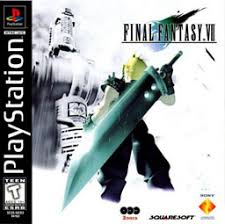
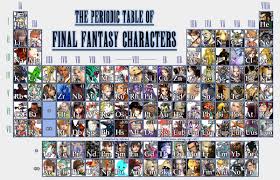
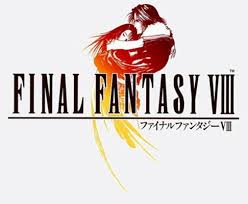
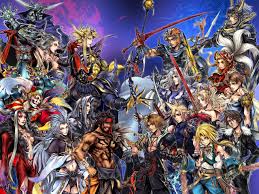
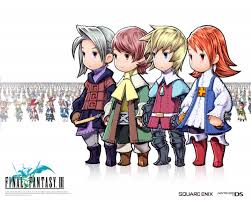
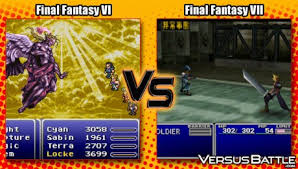

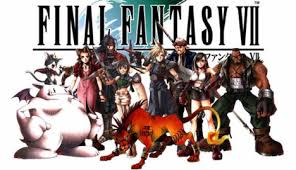

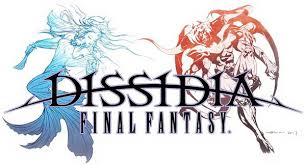
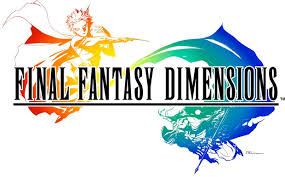
In Final Fantasy II, The Emperor's dark side goes to Hell when he is killed and takes it over, raising its capital, Pandaemonium, to Earth. As well, the Emperor's light side ascends to Heaven and enters Arubboth, Capital of Heaven. Firion and his allies kill the Dark Emperor, while Minwu and the spirits of other dead characters kill the Light Emperor, ensuring the Emperor is destroyed and gone for good.
In Final Fantasy III, there is a world of light and a world of darkness. Each world also has a group of heroes arise to save their world from being consumed by the opposing property. When Xande drains the Crystals of their power, he creates an imbalance between light and darkness. This causes the Cloud of Darkness to appear to return the universe to a state of nothingness. The Warriors of Light attempt to stop her, but are defeated. However, through the aid of the Warriors of the Dark, the Warriors of Light are able to overcome her and destroy her.
In Final Fantasy IV, there is the Blue Planet, which has two parallels; the Red Moon, and the Underworld. The surface world has four Crystals of Light, and the Underworld has four Crystals of Darkness. The Red Moon also has eight Crystals, four each of Light and Darkness. Cecil Harvey is a Dark Knight who becomes a Paladin by receiving the light-aligned power of his father Kluya. Golbez, Cecil's older brother, is aligned with darkness and uses powerful black magic to collect all eight Crystals in his quest for power. In the game's finale, Golbez uses a Crystal to attempt to subdue Zeromus, but fails as his heart is tainted with darkness. He thus passes the Crystal to Cecil, who uses his light to render Zeromus vulnerable and defeat him.
In Final Fantasy V, the world was split in two to contain the power of the Void. Each world has a set of four Crystals which are key to maintaining the worlds. When the warlock Exdeath escapes from his sealing, he destroys the Crystals, forcing the two worlds back together and unleashing the Void. The two generations of the Warriors of Dawn combine their powers to destroy Exdeath and recreate the Crystals.
In Final Fantasy VI, the War of the Magi 1000 years prior nearly destroyed the world. This conflict was caused by a war between Espers and humans. In the present, the Gestahlian Empire is seeking Espers to take over the world, leading to the possibility of the destruction of the world. One character, Terra Branford is a hybrid of an Esper and a human and represents the hope that the two races could co-exist. Terra fights to defend the hopes of the orphans of Mobliz, who have given her life meaning. The antagonist Kefka Palazzo is an experimental Magitek Knight driven insane and power-hungry, who believes life is meaningless and that love and hope are illusions.
In Final Fantasy VII the conflict between light and darkness is replaced by a conflict between nature and humanity, and science and magic. Sephiroth, representing the power of science as a genetic experiment of the Shinra Electric Power Company, uses the Black Materia to summon Meteor to ravage the planet. Aeris Gainsborough, last of the magical Cetra, uses the White Materia to summon Holy which can stop Meteor.
The dualism between Aeris and Sephiroth is clarified in The Reunion Files, where Tetsuya Nomura states "as long as Sephiroth exists, Aerith must exist". The Lifestream also serves as a cycle, as all living things, even plants, have spirit energy that comes from the planet. When someone dies, their spirit energy returns to the planet and their knowledge joins the collective. The Shinra are draining this spirit energy to produce Mako, and spirit energy is also the basis for the creation of Materia.
In Final Fantasy VIII, Squall Leonhart is opposed by his arch-rival Seifer Almasy. Squall wears a black jacket and pants while Seifer's are white in color, and the two use Gunblades to battle, each having their own preferred model and fighting style. Likewise, the love interest of Squall, Rinoa Heartilly is contrasted with the final boss of the game Ultimecia. Both are extremely powerful sorceresses; one easy-going and innocent while the other is cruel and heartless. Rinoa is symbolized as an angel with many references to angels from her dog, Angelo to the pair of white wings on her back. Ultimecia on the other hand sports huge black wings and even has her own Griever on her side.
In Final Fantasy IX, there are two worlds—Gaia and Terra. The Terran world was destroyed many centuries before the game began, so the Terran people attempted to assimilate Gaia by sealing themselves in sleep and gradually replacing the souls of Gaia with those of Terra's. To assist them, the villain Kuja was created as an "Angel of Death" to encourage death and war on Gaia and speed up the process. Later, a second Angel Zidane Tribal was created, the game's main protagonist.
In Final Fantasy X, the monster Sin was created by Yu Yevon to destroy any machine-based settlement that grew too large. However, a Summoner is able to appease Sin and hold off this destruction by using their Final Aeon to destroy Sin. But when this happens, the spirit of Yu Yevon within Sin possess that Aeon, transforming it into a new Sin and continuing an endless cycle. By destroying Yu Yevon himself, Tidus and the Summoner Yuna are able to end the cycle and destroy Sin for good. However, in the process, the world that has been dreamed up by Yuna's aeons is destroyed, causing Tidus to disappear.
In Final Fantasy X-2, the concept of dualism is present in the form of Yuna and Shuyin: Yuna is a human seeking for her lost lover while also being a witness of new Spira rising, Shuyin is an unsent wishing to destroy Spira as his grief and anger to avenge his lover's death.
In Final Fantasy XI, the enlightened races—those races believed to have been created by Altana, the Dawn Goddess, a good deity—face off against the hordes of beastmen—races created by Promathia, the Twilight God, who is twisted and evil—on Vana'diel.
Final Fantasy XII represents the conflict between despotism and self-management in two aspects: the main characters witness the rise of the Archadian Empire and its conquering of the Kingdom of Dalmasca, and sequentially ally themselves with the Resistance force against Archadia. The main antagonists' motifs are also to free mankind from the divine control of the undying Occuria, who have fiercely intervened in the history of mankind, and give mankind their own means, which are comparable to the gods', to craft its future. In the end of Final Fantasy XII, both these goals are achieved by the heroes.
In Final Fantasy XIII, the two lands of floating Cocoon and the lowerlands of Gran Pulse, two separate worlds that both view the other as corrupt or evil plays on the dualist theme. Additionally the roles of fal'Cie and humanity on each world is also reversed in that on Cocoon, humanity relies upon the fal'Cie for survival, while on Pulse the fal'Cie are almost indifferent.
In Final Fantasy XIII-2, there are still two worlds, but with a different dualism approach: the passage of time. While Gran Pulse and Cocoon are in constant movement with time paradox appearing within their timelines, Valhalla is a place where past, present, and future intersect, meaning that time doesn't flow "as it should" there. Another, plainer example of dualism are the characters Lightning and Caius, whose goals are complete opposites: Lightning wants to save the goddess Etro and protect the world, while Caius wants to kill Etro and trigger the apocalypse.
In Lightning Returns: Final Fantasy XIII, the two worlds of the previous games have been mixed together into the world of Nova Chrysalia, which itself is violently divided: two of its four landmasses are populated cities, while the other two are wild, untamed and mostly uninhabited. The continents themselves are also opposites of each other; while Luxerion is a religious capital of prayer and Yusnaan is a pleasure city where the inhabitants enjoy their days to the full, while the Dead Dunes are comprised of rolling dunes and ruins and the Wildlands are covered in forests and vegetation.
In Final Fantasy XIV, the world of Hydaelyn has constantly undergone periods of abundance, known as Astral Eras, followed by catastrophes that bring scarcity and can destroy entire civilizations. These are known as the Umbral Eras. Currently, Hydaelyn is approaching its Seventh Umbral Era.
In Final Fantasy XV, the world, according to one of the characters seen in the E3 2013 trailer, is going into a state of extreme change after a very long period of stability, hinting at some kind of cycle.[1] Also, playing on the dualism theme, are the two characters Noctis Lucis Caelum and Stella Nox Fleuret (dressed in black and white respectively), who come from the opposing kingdoms of Lucis ("Light") and Tenebrae ("Darkness").